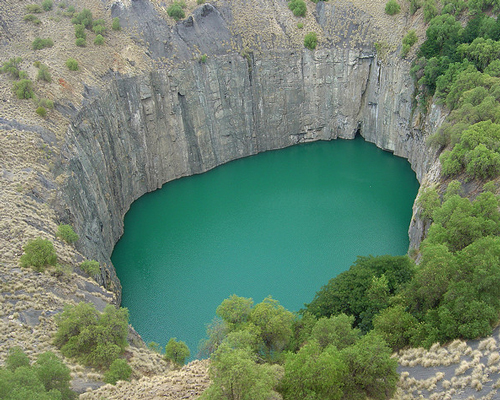The Underground Treasure of Kimberley: Journey to the World's Largest Diamond Mine
Our memory often associates diamond extraction with a specific geographical location: South Africa. However, this activity is relatively recent in that area compared to the historical exploitations in India and Brazil. It was from 1871 onwards that the discovery of large stones resulted in the immediate birth of the world's largest excavated mine: a crater over four hundred meters wide and more than a thousand meters deep.
The Kimberley mine, as it is known (also as "The Big Hole" in English), allowed the extraction of three tons of diamonds, for which it was necessary to extract twenty tons of earth. This titanic task was carried out by more than fifty thousand adventurers who settled in the area immediately drawn by the prospects of wealth.

The discovery that changed History
The story of the Kimberley mine began with the discovery of diamonds in the region, marking a milestone in the mining industry. As news spread about the existence of precious stones buried in the earth, a diamond fever took hold of the area. The magnitude of the discovery soon led to the creation of a massive crater that became the epicenter of mining activity.
The Big Hole: a monument to human ambition
"The Big Hole" is a nickname that does not do justice to the magnificence and complexity of the Kimberley mine. This gigantic hole in the earth was forged by hand, with picks and shovels, in a time when modern machinery had not yet conquered mining. Over fifty thousand fortune seekers, known as "diggers," descended on Kimberley in search of buried riches.
The crater, with its impressive dimensions, was not only the scene of intense mining activity but also a testimony to human ambition. As the excavation progressed, it became a bottomless pit that challenged the limits of resilience and determination. The earth extracted from this vast hole piled up in heaps, each containing the hope of finding the next brilliant diamond.
The challenge of extraction: twenty tons of earth for three tons of diamonds
The extraction process at the Kimberley mine was a monumental challenge. To obtain three tons of diamonds, it required extracting twenty tons of earth. This imbalance between effort and reward tested the tenacity of the miners, who, despite the difficulties, continued to dig for fortune. The perseverance of these adventurers is a testament to the fascination that the sparkle of diamonds exerts on the human imagination.
Life in the diamond fever
The massive influx of diamond seekers to Kimberley gave rise to a unique and vibrant community. The diamond fever not only transformed the physical landscape but also the social dynamics of the region. Improvised camps sprang up around the crater, creating a social fabric of hope and competition.
Life in the diamond fever was marked by uncertainty. Seekers, in their quest for wealth, faced challenging conditions, from physical exhaustion to the constant struggle for survival in a hostile environment. However, the possibility of discovering the diamond that would change their lives kept the flame of hope alive.
Legacy and evolution of Kimberley
Over time, the Kimberley mine ceased to be the epicenter of the diamond fever, but its legacy endures. Today, the city of Kimberley witnesses the evolution of the diamond industry, having transformed into a center of trade and culture. The crater, now rehabilitated and preserved as a historical site, attracts visitors from around the world, eager to immerse themselves in the fascinating history of diamond mining.
The Kimberley mine remains a symbol of humanity's quest for beauty and wealth, as well as a reminder of the transformative power of an unexpected discovery. In its depths lies not only a treasure of gemstones but also the narrative of ambition, perseverance, and determination that defines humanity in its constant pursuit of hidden treasures.


